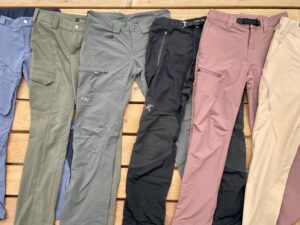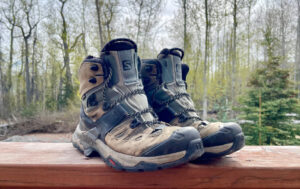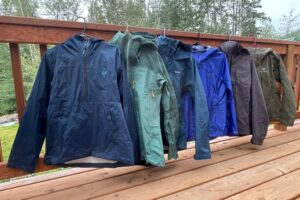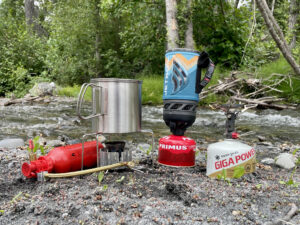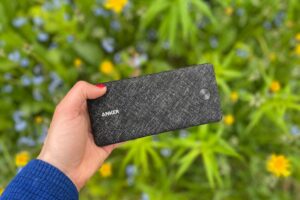A pocket knife should be strong and versatile, but compact enough to carry easily. It should cut rope, carve stakes, clear brush, and help with food prep. It should also be durable.
There is no single, perfect pocket knife to meet all these needs. However, there are quite a few options that might be right for you. We tested a variety of pocket knives for over three seasons, while camping, backpacking, foraging, and fishing. We wanted to ensure that our tested models had been put in various situations and they were suitable for all sorts of camping, backcountry, and everyday uses. Our focus was on quality and versatility, but we also paid special attention to ergonomics and size.
Without further ado, here are some of the best pocket knives on the market.
Editor’s Note: We updated this guide on July 25, 2024, to announce the Smith & Wesson Extreme Ops Folding Knife as the Best Budget Pocket Knife. We also included new categories for the Best Pocket Knife for Climbing and Best River Knife.
Our Picks for the Best Pocket Knives
- Best Overall Pocket Knife: Benchmade Bugout
- Best Budget Pocket Knife: Smith & Wesson Extreme Ops Folding Knife
- Most Versatile Pocket Knife: 5.11 Ferro Knife
- Best Pocket Knife for Climbing: Petzl Spatha Knife
- Best Boating Knife: NRS Pilot Knife
Best Overall Pocket Knife:
Benchmade Bugout
Features: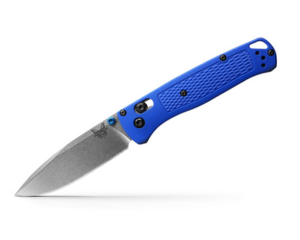
- Incredibly lightweight, without compromising durability
- Ergonomic, textured grip that is fully ambidextrous
- Reversible clip with a lanyard hole for versatile carrying options
- Benchmade offers free sharpening services for life
Why we like it: Durable, lightweight, and versatile
What we don’t like: Expensive
Overall length: 7.5 in. | Blade length: 3.3 in. | Blade steel: CPM-S30V Premium Stainless Steel | Handle material: Grivory | Lock type: Axis lock | Weight: 1.9 oz.
The Benchmade Bugout ($180) is a power-packed knife in a pocket knife package. Kirby has had this knife for years and uses it for camping, backpacking, gear repairs, foraging, and more. It’s razor-sharp to this day, comes backed by an incredible company, and the Grivory handle is highly textured.
The blade length is a bit short at 3.24 inches, but that makes this versatile knife more discreet and easy to tuck into a pocket, bra, sleeve, or bag. While you won’t be splitting wood with it, it works well for food prep and easy tasks around camp. Benchmade is a leading knife manufacturer, known for its quality knives and premium steel. The Benchmade Bugout is backed by their warranty and their LifeSharp Services. They’ll resharpen your knife to a factory edge for free, for the knife’s lifespan. Read our in-depth review of the Bugout here.
Best Budget Pocket Knife:
Smith & Wesson Extreme Ops Folding Knife
Features:
 Double-edged, partially serrated blade
Double-edged, partially serrated blade- Ambidextrous thumb knobs
- Finger flipper for easy opening
- Aluminum handle with jimping for better grip
- Pocket clip for carrying
Why we like it: Affordable, versatile, easy to access and use
What we don’t like: Blade deployment can be slow
Overall length: 7.1 in. | Blade length: 3.1 in. | Blade steel: 7Cr17MoV black oxide stainless steel | Handle material: Aluminum | Lock type: Liner lock | Weight: 3.5 oz.
The Smith & Wesson Extreme Ops Folding Knife ($22) is an impressive little pocket knife for its price point. It’s an aggressive-looking knife, but it doesn’t sacrifice function for some silly notion of looking “extreme.” It’s a beautifully balanced pocket knife, with a 3.1-inch blade fashioned from 7Cr17MoV black oxide stainless steel. The blade is double-edged, with a partially serrated blade that makes it a great choice for both push cuts and small sawing cuts. You’ll have no trouble cutting either tinder or a block of lunch cheese.
The handle is made of aluminum. While it’s not the most durable metal, it is lightweight and fits well in your hand. There’s also a snug pocket clip for easy carry. The blade is held with a liner lock, which can be difficult and sluggish to open. However, for just over $20, there’s no real reason not to buy this knife, particularly if you’re new to pocket knives or only use them occasionally.
Most Versatile Pocket Knife: 5.11 Ferro Knife
Features:

- Serrated edge and smooth sharp edge
- Integrated ferro rod with a wrist lanyard
- High visibility coated stainless steel blade
- Teflon protective coating for easy cleaning
Why we like it: Versatile knife with fire-starting capabilities, compact, easy to clean
What we don’t like: Carrying case is prone to losing screws, ferro rod takes some getting used to
Overall length: 5.8 in. | Blade length: 2.3 in. | Blade steel: Stainless steel | Handle material: Stainless steel | Lock type: None | Weight: 4.9 oz.
The 5.11 Ferro Knife ($32) is geared toward the survivalist and bushcraft community. Kirby loves having this versatile knife in her arsenal. In addition to the stainless steel blade and serrated blade, there’s an included ferro rod that’s capable of producing a 3000˚F spark for fire starting. The ferro rod nests into the handle, and the sheath is designed so you can strike the ferro rod without unsheathing the blade. It does take some practice, however. We recommend learning to use the ferro rod at home before having to rely on it in the backcountry.
The blade itself is Teflon-coated stainless steel, making for seamless cleaning. The blade is a little short, at just two inches long, but that helps keep the overall knife compact. A clipped sheath lets you carry the knife on your belt, though we have noticed some durability issues with the sheath.
Best Pocket Knife for Climbing:
Petzl Spatha Knife
Features: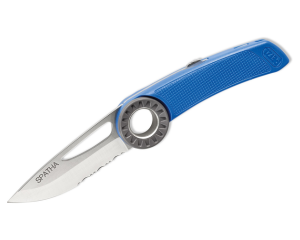
- Hole to clip a carabiner to attach to a harness
- Notch in blade for opening with bare hands
- Textured wheel for opening blade with gloves
- Smooth and serrated blade easily cuts ropes and cordage
Why we like it: Incredibly light, easy to attach to harness, serrated blade section for cutting rope
What we don’t like: No locking mechanism when closed, though the blade does lock in the open position
Overall length: 6.9 in. | Blade length: 4 in. | Blade steel: Stainless steel | Handle material: Nylon | Lock type: None when closed | Weight: 1.5 oz.
The Petzl Spatha Knife ($40) is Chelsey’s go-to knife for any climbing and mountaineering trips and most of her backpacking trips. The Spatha is a clippable knife that was designed for climbing, with a carabiner hole in the center that lets you easily clip it to your harness or backpack. Chelsey generally carries one on her gear loops, and it is low-profile enough that she doesn’t even notice she has it until she needs it. The blade itself is partially serrated, letting you easily cut ropes and cordage, while the straight section is perfect for food prep.
A textured wheel in the center makes the knife easy to open even when wearing belay or snow gloves, and the nylon handle is both lightweight and grippy. The blade doesn’t have a lock mechanism to keep it closed but does have a button lock to keep it open. While Chelsey’s never experienced the knife opening on accident, the lack of a locking mechanism is something to be aware of.
Best Boating Knife:
NRS Pilot Knife
Features:
- Quick-release Thumbs Up Sheath™ stashes fixed blades securely and releases with a one-handed flick of the thumb
- Partially serrated edge cuts through tough fibers
- Glass-reinforced polypropylene handle with a rubber overlay provides maximum blade control in wet environments
- Oxygen valve wrench in the center of the handle
Why we like it: Durable, purpose-built yet versatile, and easy to access while on the water
What we don’t like: Can be difficult to attach to your lifejacket
Overall length: 7.3 in. | Blade length: 3.7 in. | Blade steel: 420 HC stainless steel | Handle material: Glass-reinforced polypropylene with a rubber overlay | Lock type: None | Weight: 4.4 oz.
The NRS Pilot Knife ($50) was purpose-built for professional and recreational freshwater boaters, with rescue in mind. Chelsey uses one for all of her packrafting trips in Alaska, and it lives on her PFD. The blunt tip protects against accidental punctures, especially in a soft boat like a packraft, while the cutting edge has both smooth and serrated sections. The serrated section, with reverse scallop serrations, easily cuts through rope and cordage. The polypropylene handle has a rubber overlay to increase grip in wet conditions.
When not in use, the blade stores securely in its sheath, which fastens to your PFD. While it’s difficult to wrangle the sheath onto your PFD, once you get it on it’s very secure. The sheath is low profile, with a quick release function so you can release the blade with the flick of a thumb in emergencies. There’s also a lanyard attachment at the base of the handle, so you can attach the blade more securely in rough water. Chelsey’s never experienced the knife slipping out of the sheath, but it’s certainly not impossible, especially given the quick-release mechanism.
NRS also offers a smaller version, the Co-Pilot Knife, with a 2.8-inch blade, as well as a folding version called the Pilot Access Folding Knife. They even offer a titanium version, the NRS Titanium Pilot Knife, for saltwater use. We also tested it around camp and found it useful for prepping food and general use.
Honorable Mentions:
Opinel Carbon Steel Camping Knife
- 3.25in carbon steel blade

- Beachwood handle
- Virobloc safety ring
- Can be exchanged in cases of manufacturing defects
The Opinel Carbon Steel Folding Pocket Knife ($20) provides an excellent cutting edge that stays dangerously sharp for a long time. The Beachwood handle looks simplistic but is surprisingly effective from an ergonomic standpoint. And of course, all Opinel knives sport the Virobloc safety ring which ensures your fingers won’t fall victim to a blade that closes accidentally.
If you want to, you can purchase a sheath that will allow you to carry the knife on your belt. You couldn’t call this a survival knife, but for most tasks around the campsite, it will do the trick. We love this blade, particularly for foraging, and it is an excellent mushroom companion.
Spyderco Tenacious Plain Edge
- G-10 laminated handle

- 8Cr13MoV stainless steel blade
- Four-way pocket clip
The Spyderco Tenacious ($92) sports an 8Cr13MoV stainless steel blade that will more than live up to its responsibilities and an overall balance that is quite good for a folding knife. The blade is 3.39 inches long, and the knife tips the scales at a svelte 4oz.
The handle is comfortable and offset to maximize leverage while inside there are steel liners that work to increase the rigidity of the handle so you can take advantage of that leverage. Great for cutting stakes or cutting steaks.
About our testing process
The ExplorersWeb team collectively has untold decades of testing and reviewing experience under our belts, and both Kirby and Chelsey have been carrying pocket knives for decades. Kirby started this guide in 2022. She’s had a pocket knife as an everyday carry item for at least 10 years and has been camping since she was a child. Her dad taught me how to properly handle a sharp blade when she was young, and she enjoys helping others get educated on how to use camping knives safely and responsibly.
Gear Editor Chelsey Cook picked up this guide in July 2024. She lives in a cabin in the Alaskan mountains and has also been guiding backpacking and mountaineering trips for over six years. She uses her pocket knives more than she uses her own kitchen knives and needs a knife that is durable, light, and holds an edge. Chelsey also likes specialized knives for different activities and uses an NRS Pilot Knife for river sports and a Petzl Spatha Knife for climbing.
This guide is for anyone who uses or wants to use a pocket knife. Selecting the best pocket knife is no easy feat, and your needs will vary greatly depending on how you’re planning to use your knife — for bushcraft work, processing game, foraging, campsite repairs, food prep, or rescue situations. We’ve included fixed blades and folding knives, specialized knives for different applications, knives with both straight and serrated edges, and knives of all different sizes.
We selected the best pocket knives after extensive market research and years of testing. We tested our favorite high-quality knives while foraging, camping, and as everyday carry options. Our editor’s choice model has spent years as a trusty sidekick to Kirby and has rightfully earned the title of the best pocket knife. Our newer favorites were still put through rigorous testing all over the Pacific Northwest and Alaska, in a variety of weather conditions and terrain.
Features to look for in pocket knives

Knife blade steel
Steel, an alloy of carbon and iron, is the most commonly used material for knife blades because of its hardness and ability to retain an edge. There are an incredible number of different knife steels out there, all created by adding different additives and different finishing processes. New knife steels are coming out every year and can be hard to keep up with. Generally, knife steels are all quite good, though you want to make sure the knife steel you choose meets these requirements.
Wear resistant
Your knife steel should be able to withstand general use wear, including both abrasive and adhesive wear. Wear resistance usually has to do with a steel’s hardness, as well as the chemistry of the steel.
Corrosion resistant
You don’t want a knife steel that will rust at the first sign of humidity or moisture. Some knife steels are more resistant to water than others, and if you’ll be using your knife in wet environments you may want to prioritize corrosion resistance over other factors.
Edge retention
This affects how long the blade will remain sharp after repeated use. While you can sharpen pocket knives, you want your knife steel to hold its edge for as long as possible. This generally comes down to wear resistance and a blade that is not prone to chipping or cracking. Make sure you can easily sharpen your pocket knife too; serrated blades, for instance, are harder to sharpen in the field than straight blades are.

The Benchmade Bugout is a capable folding knife with a Grivory handle. Photo: Kirby Kahl
Handle material
While ergonomics play a role in a pocket knife’s grip, the material used in the handle, also known as the knife scale, has the greatest effect. You want a material that is durable, lightweight, and grippy in a variety of conditions.
Carbon fiber
Carbon fiber is a polymer that is five times stronger than steel and incredibly lightweight and durable. It’s becoming increasingly popular in knife handles because of its strength-to-weight ratio and durability. It’s not cheap, however, and knives with carbon fiber handles will be on the pricier end.
Nylon and plastic
Nylon and plastic are durable and lightweight synthetic materials that are popular for knife handles because they are typically textured, offering increased grip. Handles made with nylon or plastic go by a variety of different names, including Grivory (injection molded), GRN (glass-reinforced nylon), GFN (glass-filled nylon), and FRN (fiber-reinforced nylon).
G10 and micarta
G10 and micarta are both composite materials that are created by layering fabric sealed with resin or epoxy and then compressing it under heat. Both materials were designed for their durability and are common in household appliances, including knives.
G10 is nearly waterproof, while micarta is fully waterproof, though more susceptible to dents and dings than G10. Both materials are resistant to temperature extremes and don’t become brittle over time.
Aluminum and titanium
Aluminum, particularly anodized aluminum, is lightweight and durable. However, it is a relatively soft material when compared to steel or titanium, and prone to scratches and dents. Titanium, while more expensive, is much more durable and more lightweight.
Wood
Wood was the traditional material used for knife handles. It’s durable, provides grip, and is aesthetically pleasing. Hardwoods are ideal, and common types of wood handles include walnut, oak, and maple. Wooden handles do require some maintenance to keep them looking and performing their best; you may need to treat them with oil or wax to prevent them from drying out and to increase their water resistance.
Blade coating
Blade coatings offer a few benefits: they change the look of the knife, as well as make it more durable and resistant to corrosion. Mirror-polished offers great corrosion resistance. Stonewashing hides scratches and is less reflective than other coatings. Bead-blasting gives you a router blade surface that is more prone to corrosion but is not reflective. A satin finish is arguably the most popular and is right in the middle of bead blasting and mirror polishing.
Blade length
For an everyday carry knife (EDC), most people like a medium-sized blade that falls somewhere between 2.5 and 4 inches. This blade length is still versatile enough to handle most tasks while being small enough to carry in your pocket. Different states have different laws restricting knives based on blade lengths. California, for instance, prohibits blades longer than 4 inches in public buildings, while Colorado doesn’t allow concealed carry knives of over 3.5 inches. Check with your state’s laws before purchasing a knife.
Type of blade point
A drop point blade offers additional strength and control at the tip with a slow curve that lowers the point at the tip of the knife. This makes for an excellent hunting, tactical, and survival knife. A clip point is better for piercing tasks but offers less strength. Spear point knives are great for piercing and stabbing and are often used as throwing knives. When it comes to finding a good knife that can handle heavy-duty tasks, drop-point blades are the primary choice for the best camping knives.
Comfort and ease of use
You want your EDC to be comfortable to hold and easy to use. Otherwise, it’s more likely to stay at home rather than ride in your pocket. Handle ergonomics, lock mechanisms, and carry methods all affect how likely you are to use your knife.
Handle ergonomics
The shape and material of the handle scales, the thickness, and the weight all affect how a knife fits in your hand. The handle should be comfortable, grippy, and not fatigue your hand while using. Each person has different preferences, so try to handle as many knives as possible before deciding on your next knife. This is particularly important if you plan on using the knife as an EDC or using it extensively.
Lock mechanism
Folding knives come with different locking mechanisms. The most popular are the liner locks, which use a piece of metal against the tang, frame locks, which use a bar that indexes into the back of the blade, button-style locks, which use a steel barrel to keep the blade out, and crossbar locks, which use a steel bar to hold the knife straight.
The best lock mechanism for you is one that you can open and close easily, preferably with one hand. You may need to practice with a new knife for a while before you get comfortable and efficient at locking and unlocking the blade.
Carry methods
While pocket knives are primarily designed to be carried in your pocket, some brands offer other carry methods, like pocket clips that can clip to the outside of your pocket or belt. The Petzl Spatha has a strong metal loop that you can clip a carabiner through, making it a great choice to wear with a climbing harness, while the sheath of the NRS Pilot Knife has a large clip for clipping to a lifejacket. Other knives may have loops of paracord on the handle. Think about how you want to carry your EDC (do you want to slip the knife in your pocket, carry it on your belt, or do you have specific carrying needs?) and then go from there.
Types of pocket knives

The NRS Pilot Knife is a part of Chelsey’s rescue kit on all of her packrafting trips. Photo: Chelsey Cook
Fixed-blade knives
Generally, a fixed-blade knife is stronger than a foldable knife. The fixed blade and handle provide strength and tactical advantages that are quite valuable in a survival knife. These blades are easier to clean and less prone to breaking. However, a fixed-blade knife is harder to conceal and takes up substantially more space than a folding knife.
Folding knives
A folding knife folds easily into a pocket for concealment and transport. A small folding knife can be a great tool for backpackers, those looking to save space, or for those who want something as an everyday carry option. These models can also provide a small layer of safety around children, given that the blade is not exposed without effort. However, these blades require more maintenance, are not as strong as a fixed-blade knife, and take more time to be ready for action.
Multi-tools
While multi-tools like a Swiss army knife are handy for their versatility, as camping knives they often fall short and we recommend having a backup on hand. The blade edge available is often short and doesn’t offer much working area. These can be helpful in a pinch but not as primary survival knives.
Drop-point blade knife
A drop-point blade is one of the most popular choices for both a camping utility knife and a hunting knife. In a drop point blade, the back of the knife lowers in a slow curve offering more strength and control at the tip.
Pocket knife care

A good camping knife is a precision tool that can not only cut your bacon but might also save your life in an emergency. As such, it deserves to be treated with the same respect you’d show your tent or hiking boots. Therefore:
- Don’t put your knife away until it’s clean and dry – Your pocket knife is a workhorse, so it’s going to get wet and dirty. That’s unavoidable. What is avoidable, however, is putting the knife away when it’s in such a state. Always make sure that your pocket knife is clean and dry before putting it away.
- Hone the blade regularly – Honing the knife on a regular basis ensures the blade is always crisp and sharp. Honing the blade is roughly akin to changing the oil in your car while sharpening the blade is like bringing the car in for a tune-up. Hone after each use if you can.
- Don’t abuse the knife – A pocket knife is designed to handle tasks like whittling stakes, cutting rope, and cleaning fish. Unless it has a pommel built into the base it should not be used as a hammer. Also, don’t use the knife as a screwdriver or an ice pick, and don’t practice throwing it.
- Lubricate your knife – Folding knives need to be kept properly lubricated. Most will use some type of oil-based lubricant that is applied to the various moving parts. Be sure to wipe away any excess.
Frequently asked questions about pocket knives
What is a pocket knife?
Pocket knives, also known as EDC knives, are small knives that generally fit in your pocket. Most of them are folding knives, though some are fixed blades that can be carried on your belt. Most pocket knives are defined as heavy-duty knives, typically full tang, with a blade under five inches. They’re useful in both the frontcountry and the backcountry.
How do you properly clean a pocket knife?
Cleaning a knife in the backcountry can be tricky, but a wash with soap and water generally does the trick. At the very least, wipe the blade down to remove all visible debris before putting it away. A more thorough scrub can be completed when you are home.
How sharp should a pocket knife be?
A camping knife should be sharp enough to handle anything you throw at it, including food prep and bushcraft work. However, a too-sharp knife could pose a problem if there is a mishap and medical attention is far away. Balance is key.
Should I get a straight-edge or a serrated-edge pocket knife?
Most pocket knives have a straight edge, which is ideal for push cuts, such as shaving, and slicing. Some fixed-blade pocket knives have a serrated edge, which is useful for sawing tough rope or wood. In general, straight blades are fine for pocket knives. They give you better control, cleaner cuts, and are easier to sharpen. Serrated blades are not as precise, and are more tedious to sharpen and maintain.

